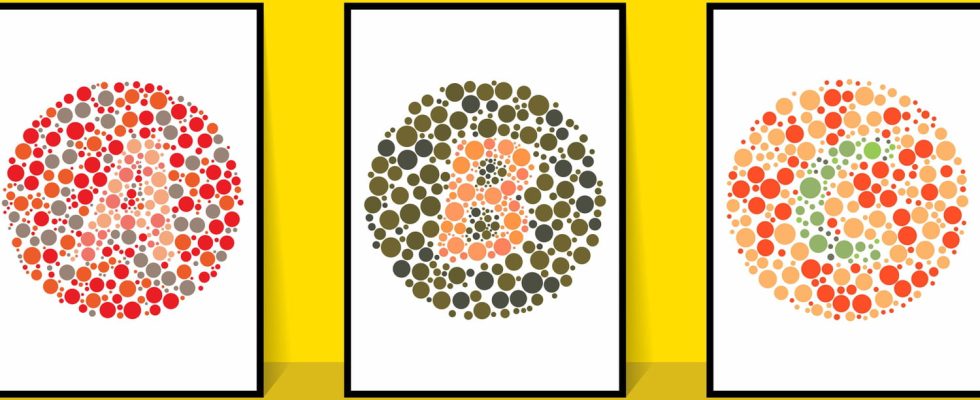Color blindness (now called dyschromatopsia) is a genetic disorder characterized by impaired color perception. The most common form is confusion between red and green.
Today, the medical term for color blindness is dyschromatopsiawhich corresponds to a color perception disorder. In common parlance, the terms “color blindness” and “color blindness” are still used. Color blindness almost exclusively concerns men and it is estimated that 8 to 9% of the male population is affected. Women are exceptionally affected. The most common form is confusion between red and green. What colors does a color blind person see? What is the test to detect color blindness? Is it genetic? Hereditary? What are the risks of transmission? Insights from Professor Antoine Brézin, professor of ophthalmology at the faculty of medicine of Paris-Cité University, head of the Ophthalmology department at Cochin Hospital and author of the book Understanding and caring for your eyes (Editions du Cerf).
What is the definition of color blindness?
“We use the term “color blindness” less than in the past (or even more at all). This word, however, remained in everyday vocabulary. Now we talk about “color vision disorder“or of”dyschromatopsia” which means that the person does not correctly distinguish all colors“, explains Professor Brézin. For the anecdote, “Color blindness” is derived from the name of John Dalton, a British chemist and physicist who described and analyzed color vision at the end of the 18th century, after observing his own alteration colours.
What are the causes of color blindness?
In the retina there are rods and cones. The cones are photoreceptors which allow colors to be distinguished. There are 3 types of cones : red cones, green cones and blue cones. It is thanks to the mixture of responses to these different cones that we can reconstruct the colors. The normal human eye perceives the entire palette of colors, from purple to red, by analyzing the mixture of signals received by these three types of cones, indicates our interlocutor. “Most color vision disorders are of genetic origin : there is a mutation (anomaly in one of the genes) in these cones which means that color perception is impaired. There are a multitude of different alterations, more or less frequent. The most common alteration is the confusion between red and green (called red/green axis dyschromatopsia). More rarely, certain color perception disorders are not congenital but acquired and secondary to an overdose of certain drugs (in particular a drug used in the treatment of tuberculosis)“, explains Professor Brézin.
For a dyschromatic person whose form of dyschromatopsia has a red/green axis, red and green appear the same and perceives colors as in the circle below on the right.
Is it true that color blindness only affects men?
Most dyschromatopsias affect men: it is estimated that approximately 9% of the male population is affected by a color perception disorder, while only 0.5% of women have dyschromatopsia. This is simply explained by the fact that “Most of the cone pigment genes are located on the X chromosome. Women have two colors (this is called X-linked recessive inheritance). Men have an X chromosome and a Y chromosome and cannot “compensate” for the mutation on the X chromosome with the other chromosome.“, explains our interlocutor.
Is color blindness hereditary?
“Yes. Women, who are onlyexceptionally affected by dyschromatopsiacan transmit the genetic mutation to their children: their male children have one chance in two of being affected by this vision disorder colours“, explains our interlocutor.
Is there an official test to diagnose color blindness?
Dyschromatopsia is detected at school with the Ishihara test (developed in 1917) which makes it possible to detect red/green axis dyschromatopsia. The test consists of a series of boards with red numbers in green circles (or green numbers in red circles, see image below).
→ A person with normal color perception distinguishes numbers inside circles
→ A person with red/green axis dyschromatopsia cannot distinguish numbers inside circles.
Is there any treatment for color blindness?
As it is a genetic disorder, there is no support or treatment. “We are born that way and we stay that way for life. Generally, dyschromatic people experience it quite well on a daily basis, however, it is important to know it early enough for professional guidance.“, underlines the expert.
What professions are prohibited for color blind people?
The presence of a color perception disorder is decisive for the choice of a professional orientation and certain professions are, in fact, closed to dyschromatics: electrician, train driver, airplane pilots, certain artistic professions (stylist, painter, etc.). This is why it is very important to do screening in schools.
Can you drive a car when you are color blind?
It is entirely possible to drive a car with a color vision disorder because even if we confuse green and red, the position of the traffic lights allows you to know whether it is a red light (positioned at the top) or a green light (positioned at the bottom).
Thanks to Professor Antoine Brézin, professor of ophthalmology at the faculty of medicine of Paris-Cité University, head of the Ophthalmology department at Cochin Hospital and author of the book Understanding and caring for your eyes (Editions du Cerf).

